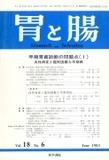Japanese
English
- 有料閲覧
- Abstract 文献概要
- 1ページ目 Look Inside
良悪性の鑑別困難な陥凹型早期胃癌と言えば,従来はⅢ型あるいはⅢ+Ⅱc型早期胃癌が挙げられていた.しかしX線・内視鏡診断の進歩に伴い最近では微小癌やⅡb型早期胃癌が見付けられるようになり,これらの微細な病変と胃炎などとの鑑別が問題となっている.1982年秋の消化器病3学会合同秋季大会のポスターシンポジウム“肉眼的に悪性所見を認めにくい早期胃癌”で取り挙げられた陥凹型早期胃癌の症例を見ても,ほとんどが微小癌か浅いⅡc型早期胃癌で,類似Ⅱbとも言うべき症例を扱った報告であった.そこで,浅いⅡc型早期胃癌とⅢ型あるいはⅢ+Ⅱc型早期胃癌について症例を中心にして述べる.
Radiological study was made on shallow type-Ⅱc and type-Ⅲ early gastric cancer which are difficult to be differentiated from benign lesions.
1. Shallow type-Ⅱc early gastric cancer
As seen within the recent ten years in our hospital, about 40% of all type-Ⅱc early gastric cancer has shallow depression. In these cases the outline of each lesion is not very clear especially in those without converging mucosal folds which make it difficult to differentiate from benign legions.
In this paper three cases of shallow type-Ⅱc early gastric cancer are presented. In these cases, faint barium collections and barium lucent granular shadows were detected by x-ray examination, but the outline of each lesion was not so clear. Then diagnosis of shallow type-Ⅱc early gastric cancer was made from the radiological findings of the depressed area. In order to diagnose almost-flat-type early gastric cancer, we considered it necessary to examine the radiological mucosal pattern in details. Then, magnified roentgenogram of the fixed specimen of the resected stomach was studied in case 2, showing fine abnormalities of the cancerous mucosa radiologically (Fig. 4g).
2. Type-Ⅲ early gastric cancer
This type of early gastric cancer is rare in frequency. In spite of advancement in radiological diagnosis of early gastric cancer, diagnosis of this type of early gastric cancer is still difficult because cancerous infiltration is limited to the rim of the ulcer. Still more, a lot of gastric secretion and edematous change disturb accurate diagnosis. In the present paper we illustrated two cases of type-Ⅲ or Ⅲ+Ⅱc early gartric cancer, and reviewed a few problems in their diagnoses.
The concept of the malignant cycle is well-known today, and in cases that have prominent excavation, follow-up examination must be carried out for exact diagnosis. In case 4, a giant niche with smooth margin was in the first examination, but typical findings of type-Ⅱc early gastric cancer appeared four months later (Fig. 7c).
For the accurate diagnosis of type-Ⅲ or Ⅲ+Ⅱc early gastric cancer, the most useful radiological sign is an irregular outline of its shadow. In addition, irregularity of the area gastricae around the niche should be distinguished from the niche radiologically. And, it is well known that compression study must be recommended as an appropriate radiological examination.

Copyright © 1983, Igaku-Shoin Ltd. All rights reserved.


